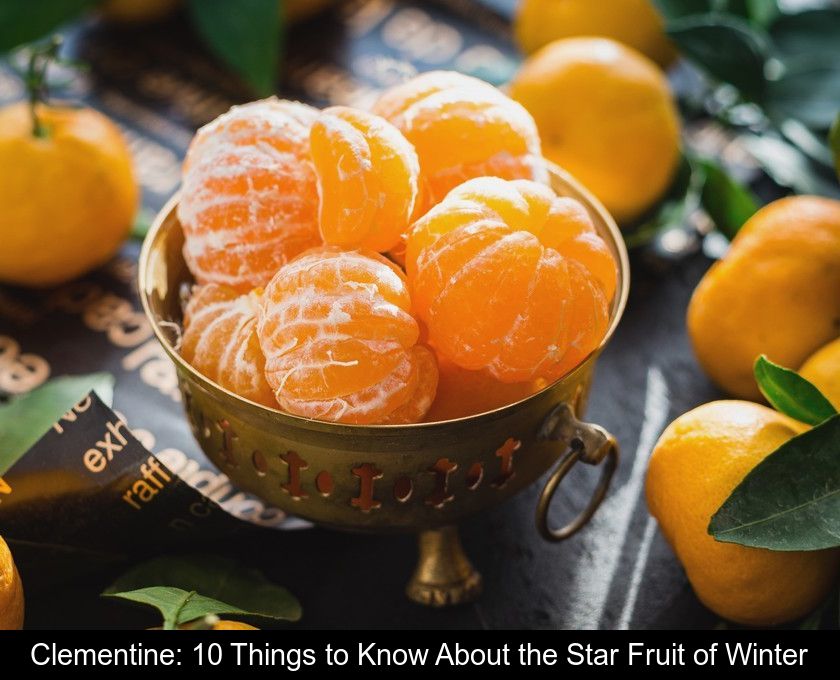Clementine: 10 Things To Know About The Star Fruit Of Winter
Juicy and fragrant, the clementine is one of the fruits eagerly awaited on the market stalls. We invite you to discover 10 facts and anecdotes about this fruit that has become inseparable from the end-of-year festivities.
1- The clementine is a hybrid fruit.
The clementine is the fruit resulting from the cross between a mandarin and a bitter orange.
Its botanical name is Citrus reticulata. Just like the Mandarin tree, its close relative, the clementine tree is a member of the Rutaceae family.
2- The clementine is native to Algeria.
Although it is now cultivated on the eastern coast of Corsica by more than a hundred producers over 1200 hectares, the clementine was born on the other side of the Mediterranean.
It was created at the beginning of the 20th century in the gardens of the orphanage of Misserghin near Oran in Algeria. The first cross between a mandarin and a bitter orange was made by Father Clément, hence the name given to this new hybrid.
3- This citrus fruit is a treasure trove of benefits.
Just like the orange, the clementine is rich in vitamin C but not only that! It also provides vitamins A, B, E, and P. This small fruit is therefore a treasure trove of benefits for bodies tired from the rigors of winter.
Clementines also contain fiber, calcium, potassium, and magnesium. All this for only 20 to 25 calories per fruit.
4- The Corsican clementine benefits from a PGI.
Since 2007, the Corsican clementine has been the only clementine produced in France to benefit from a Protected Geographical Indication or PGI.
This distinction allows it to stand out from its competitors from the Maghreb, Lebanon, or Spain. It comes with a set of specifications imposing strict rules on growers:
- exclusively hand-picked.
- no chemical treatment after harvest.
- shipment to the point of sale within less than 6 days.
5- The Corsican clementine is recognized by its logo.
A few years ago, only Corsican clementines were sold with their leaves, which made them easily recognizable from afar.
Today, many fruits from other countries are sold this way. Therefore, it is important to carefully read the labels and look for the mandatory PGI logo to distinguish Corsican clementines from their foreign competitors.
6- The Corsican clementine has specific characteristics.
The Corsican clementine owes its reputation not only to its geographical origin.
In addition to being produced on the Isle of Beauty, it stands out from other clementines by:
- its long green leaves.
- its thin, orange peel (sometimes green at the base of the fruit).
- its absence of seeds (which also differentiates it from the mandarin).
- its delicate taste, with a beautiful balance between sweet and tangy flavors.
7- Its season is short.
The Corsican clementine is a fruit to be enjoyed quickly because its season is short.
This fruit, which ripens in the sun under the mild Corsican climate, is only sold in winter, from November to January.
8- The Corsican clementine has its own festival in Linguizzetta.
Each year, the town of Linguizzetta in Corsica organizes the Clementine Festival at the beginning of November.
This event marks the kickoff of the harvest and sale of this fruit.
9- Nothing is wasted in the clementine
In cooking, the clementine is used from the pulp to the peel.
Its zest can be grated into a cake or a Brioche or candied in a sugar syrup.
It will then be perfect for decorating a Yule log or a brioche King's cake. Dipped in chocolate, this candied zest makes a delicious treat comparable to the famous orangettes.
10- It is also cooked in a savory version.
With its sweet and tangy notes that charm the most discerning palates, the Corsican clementine is commonly used in fruit salads and desserts. This delicately flavored citrus fruit is often transformed into mousse, sorbet, or candied zest.
But have you ever thought of incorporating it into your savory recipes? Clementine pairs very well with shrimp and other shellfish and can be used to flavor a butter sauce intended to coat a fish.
Even more surprising, it can be sautéed in butter and served with poultry such as turkey, chicken, or duck. To change things up from duck à l'orange, why not cook this meat with another citrus fruit?






